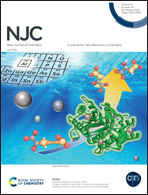The mechanism and diastereoselectivity in the formation of trifluoromethyl-containing spiro[pyrrolidin-3,2′-oxindole] by a catalyst-free and mutually activated [3+2]-cycloaddition reaction: a theoretical study†
Abstract
The mechanism and diastereoselectivity of the [3+2] cycloaddition reaction between (Z)-1-methyl-3-[(2,2,2-trifluoroethyl)imino]indolin-2-one and 5-nitro-2-vinylpyridine with no catalyst in acetonitrile to produce spiro[pyrrolidin-oxindoles] have been investigated by DFT at the M06-2X/6-311+G(d,p)//M06-2X/6-31G(d,p) level combined with the solvation SMD model. A new mechanism has been reported. Our computed results revealed that the most favoured reaction pathway has three steps: the first and second steps are the proton transfer reactions, and the third step is the [3+2] cycloaddition reaction. The reliability of this mechanism is demonstrated by the natural bond orbital (NBO) and reduced density gradient (RDG) analysis. The calculations of atomic charges, second-order perturbation stabilization energies E(2), and atomic dipole corrected Hirshfeld (ADCH) atomic charge showed that the –CF3 group facilitates the proton transfer step. The origin of the diastereoselectivity of the catalyst-free reaction was investigated by distortion/interaction analysis. It is the lower distortion energy and the stronger interaction energy in E-TS3-a that control the diastereoselectivity to generate R-configuration product 3aa. And the higher polarity of acetonitrile makes the reaction easier.
![Graphical abstract: The mechanism and diastereoselectivity in the formation of trifluoromethyl-containing spiro[pyrrolidin-3,2′-oxindole] by a catalyst-free and mutually activated [3+2]-cycloaddition reaction: a theoretical study](/en/Image/Get?imageInfo.ImageType=GA&imageInfo.ImageIdentifier.ManuscriptID=D0NJ04063K&imageInfo.ImageIdentifier.Year=2020)


 Please wait while we load your content...
Please wait while we load your content...